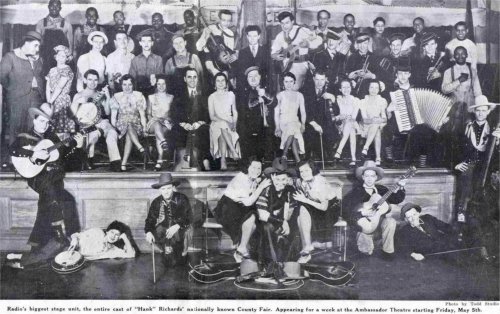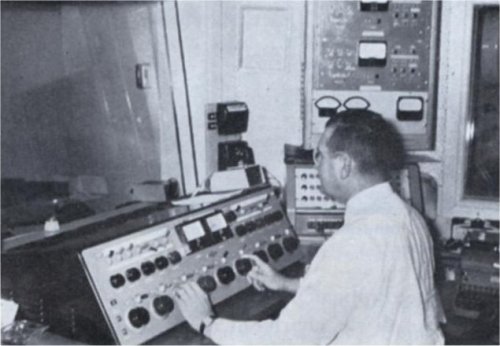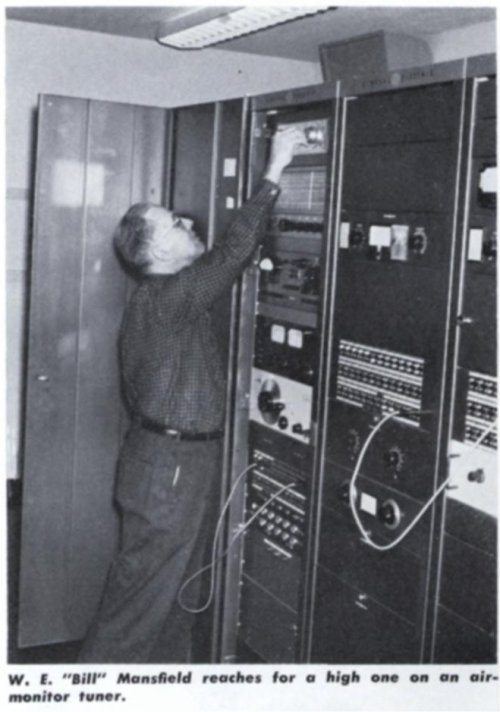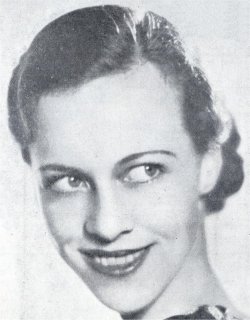Radio Articles
Glamour, Giggles and Excitement At KMOX County Fair
Giggles, a lazily strummed guitar, rollicking accordion tunes and a general scurrying of footsteps describes as nearly accurately as possible the behind-the-scenes preparation for the weekly KMOX County Fair.
The giggles have their foundation primarily in the ridiculousness of the costumes. The staff and artists enjoy seeing normally sober and dignified exponents of radio attired as clowns or impersonating monkeys. “Hank” Richards, the Barker, originator and director of the Fair changes from a correct-appearing Program Production director to a barker wearing a checked suit, a flaming orange tie and a brown derby that is really laugh-provoking.

Last Saturday night, I joined in the backstage preparations and then took my place amongst the audience. I found myself enjoying every minute of the fast-moving show, for it was a good one – I was soon as lost in complete enjoyment as the other 500 spectators. The stage represents the glitter and expansive caricatures of a side-show and when the Fair begins, “Hank” Richards takes his place in a much-decorated ticket booth and the fun has started.
Sunny Joe and his Scalawags rush in and whale into lilting music and the Girls of the Golden West, two really pretty girls from Texas, harmonize on good old range songs. When the program stops long enough for the next to be announced, Ruth Hulse Nelson, looking about ten years old in a little gingham frock, strikes up a calliope interlude. The other acts in the wings provide the cheering to join in the applause of the amused audience.
Ted Straeter at the piano and his Three Best Girls, Blanche Fink, Georgia Erwin and Louise LaRue, harmonize perfectly for a bit of more dignified music. Applause and music and then the County Fair goes on the air. There are two broadcasts each Saturday night which come directly from the stage as the show moves on.
In fast succession, The Missouri-Pacific negro quartet does a hot number or two and then Len Johnson and his Ozark Mountaineers are on and off the stage playing real hillbilly tunes. Sad Sam, looking ridiculous in a battered top hat and “tails” that far from fit, and his accordion and Sunny Joe, the bad boy of the air with is brand new All-American banjo that cost $600, tear off a bit of music and exchange wise-cracking dialogue.
In and out strolls Dr. Cuckoo wearing a somber black Stetson hat, a dilapidated frock coat, a string tie, bespectacled and with a very, very, very red nose. One snickers at the sight of him before he even attempts speech. In person he is Holland Engle, announcer and news commentator, but he looks exactly like one of the Four Horsemen in such a get-up.
He and “Hank” Richards launch into some side talk or amuse themselves by exchanging hats or trying to break up the acts. Sometimes, Dr. Cuckoo goes into a tap dance or sits at the piano and beats out a tune or two and sings. Seeing this normally well-groomed and dignified person being so ridiculous is a show in itself.
Lindhorst the magician comes out with a bag of tricks that amaze and delight the audience. Last Saturday night he chose two boys from the audience and as he took silver balls out of their hands and quarters out of the air or bowls of goldfish from his hat, their eyes grew in wonderment. His act reached the climax when he handed ten cards to one of the youngsters and the lad counted them.
This august magician commanded them to count them again and there were twelve and then fourteen. The only apparent thing that he did to increase the number that the boy held was to flip the remaining cards in his own hand and invite them to join the pack in the boy’s trembling hand. I’ve tried this one myself and it’s got me baffled – it just isn’t reasonable but it does happen!
More calliope music, more applause and then six-foot-two Wyoming Jack and Big Jim Jenkins, both from the A Slash V ranch from way out in Wyoming dash out on the stage looking very colorful in their western costumes. Cameo Cal, a new recruit to their act, expounds some workable philosophy and Wyoming Jack with his guitar yodels and sings alternately. Big Jim with a cracking whip does spectacular things like knocking the ashes off of Wyoming Jack’s cigar. It takes nerve for Jack to stand still with utter confidence that Jim’s whip will crack over his head and then descend in just the right spot.
The highlight of the gala evening came last week in an impromptu manner. “Hank” Richards had teased the acts so much that they decided to get “even” with him. Sunny Joe and Sad Sam announced that “Hank” would sing. Hank demurred but the impelling clapping from the audience necessitated his going through with it. His voice that was heard for the first time at the Fair proved to be a good tenor and his singing of “Piccaninney Lullaby” broke down the house, so to speak.
It’s a good show. I enjoyed every minute of it because most of it is inspired by ready wit. There’s good music and better fun, lights and action. That’s good entertainment in any language.
Nancy Frazer, Radio & Entertainment, 11/19/32


